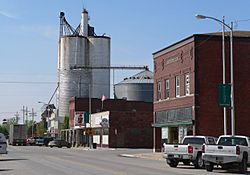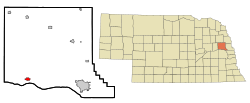North Bend, Nebraska facts for kids
Quick facts for kids
North Bend, Nebraska
|
|
|---|---|

Downtown North Bend: west side of Main Street
|
|

Location of North Bend, Nebraska
|
|
| Country | United States |
| State | Nebraska |
| County | Dodge |
| Area | |
| • Total | 1.20 sq mi (3.10 km2) |
| • Land | 1.12 sq mi (2.90 km2) |
| • Water | 0.07 sq mi (0.19 km2) |
| Elevation | 1,276 ft (389 m) |
| Population
(2020)
|
|
| • Total | 1,279 |
| • Density | 1,141.96/sq mi (440.72/km2) |
| Time zone | UTC-6 (Central (CST)) |
| • Summer (DST) | UTC-5 (CDT) |
| ZIP code |
68649
|
| Area code(s) | 402 |
| FIPS code | 31-34720 |
| GNIS feature ID | 838161 |
North Bend is a small city in Dodge County, Nebraska, United States. It's a friendly place with a population of 1,279 people as of the 2020 census. This city is known for its history and its location along an important river.
Contents
Where is North Bend?
North Bend is located on the north side of the Platte River. You can find it where U.S. Route 30 and Nebraska Highway 79 meet. A major train line, the Union Pacific Railroad, also runs through the city.
The city covers about 1.2 square miles (3.1 square kilometers) of land.
A Look at North Bend's History
Early Settlers and New Names
North Bend was first settled in 1856 by a group of Scottish immigrants. They were traveling to Kansas but stopped at a bend in the Platte River. They liked the area and decided to stay, starting a town called Franklin.
More settlers arrived, bringing important tools like a steam-powered sawmill. In 1858, a nearby town called Emerson changed its name to Wallace. This was because a kind person from Philadelphia offered to build a library there.
The Railroad Arrives
The town got its current name, North Bend, in 1864. This happened when the Union Pacific Railroad bought land for a train station. The railroad was building the first transcontinental railroad across the country. Maps showed this spot as "the north bend" because it was the northernmost point of the Union Pacific line in Nebraska. So, everyone agreed on the name North Bend.
The first train came to North Bend in 1866. The railroad officially planned out the town in 1867. By 1876, North Bend had grown to 250 people. It had many businesses, a school, and two churches. The city's first newspaper, the Independent, started in 1879.
Growth Over Time
North Bend continued to grow steadily. By 1890, the population reached 897. The city even built its own city hall. By 1920, North Bend had modern conveniences like electricity, running water, and paved streets. The population was 1,087. The town kept growing through much of the 20th century. Its population reached its highest point of 1,368 people in 1980.
People of North Bend
| Historical population | |||
|---|---|---|---|
| Census | Pop. | %± | |
| 1880 | 415 | — | |
| 1890 | 897 | 116.1% | |
| 1900 | 1,010 | 12.6% | |
| 1910 | 1,105 | 9.4% | |
| 1920 | 1,087 | −1.6% | |
| 1930 | 1,108 | 1.9% | |
| 1940 | 1,003 | −9.5% | |
| 1950 | 906 | −9.7% | |
| 1960 | 1,174 | 29.6% | |
| 1970 | 1,350 | 15.0% | |
| 1980 | 1,368 | 1.3% | |
| 1990 | 1,249 | −8.7% | |
| 2000 | 1,213 | −2.9% | |
| 2010 | 1,177 | −3.0% | |
| 2020 | 1,279 | 8.7% | |
| U.S. Decennial Census | |||
North Bend in 2010
In 2010, there were 1,177 people living in North Bend. There were 447 households, which are groups of people living together. Most people in the city were White (98.1%). A small number were African American, Native American, or Asian. About 1.2% of the population was Hispanic or Latino.
The average age in North Bend was 41.8 years old. About 27.4% of residents were under 18. Many households (57%) were married couples living together.
What North Bend Does
The biggest industry in the North Bend area is agriculture. This means farming is very important here. There are also almost 100 small businesses in the city.
The largest employer in North Bend is the North Bend Central Public Schools. They employ 76 people and serve students from North Bend and nearby towns like Morse Bluff and Ames.
News and Transportation
Local News
North Bend has its own weekly newspaper called the North Bend Eagle. This paper was created in 1897 when two other local papers merged. It is the oldest business in the city that has been running continuously.
Getting Around
You can get to North Bend by bus. Express Arrow provides intercity bus service to the city.
Famous People from North Bend
- Marg Helgenberger: An actress known for her roles in TV shows like CSI and China Beach.
- Charles H. Purcell: He was the Chief Engineer for the design and building of the famous San Francisco–Oakland Bay Bridge.
- Eddie Watt: A professional baseball player.
See also
 In Spanish: North Bend (Nebraska) para niños
In Spanish: North Bend (Nebraska) para niños

